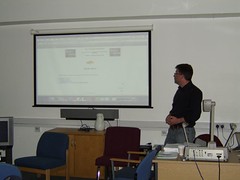Job Vacancy - Permanent Instructor - Interaction Design
The Alberta College of Art + Design is one of only four publicly
funded Canadian post-secondary institutions devoted exclusively to
the advanced education of visual artists and designers. The college
has recently entered into a vital new phase in its development and
embraced a new mandate and vision that endorses a model of the
institution as a laboratory for experimentation and as a catalyst for
research, discourse and international impact in the arts and emergent
cultural fields.
The college welcomes applications for the following full time
permanent faculty position commencing in the fall semester 2007:
Permanent Instructor - Interaction Design
Media Arts & Digital Technologies is seeking an interdisciplinary
instructor with a focus on interaction and interaction design and a
commitment to novel syntheses of new media, fine art and design. The
successful candidate is expected to teach specific skills including
prototyping, electronics, and programming in combination with theory,
seminar and studio courses to a wide range of undergraduate students
at all levels. While initially teaching through existing courses,
this position will be expected to develop new curriculum and course
offerings with innovative curricular interactions between majors.
Qualified candidates will have a terminal degree in interaction
design or a related field, or an equivalent combination of education
and practice. Additional qualifications and experience will include
the development of tangible interfaces for objects and spaces and a
strong grounding in perceptual and cognitive human factors; visual
interface design; ethnography; and the politics of design.
Demonstrated experience in one or more of gaming; information
visualization; wearable computing; or art and science or other
collaborative environments is expected. Post-secondary teaching
experience is an asset. The successful candidate will have a dynamic
and active practice in Interaction Design and is expected to maintain
a high level of research and practice and disseminate results regularly.
Please submit applications by February 23, 2007 including; a
portfolio of your work, letter of application, the names of three (3)
referees, a current curriculum vitae, statements outlining
philosophies and models of teaching and practice, and examples of
current and past research examples of your students’ work and where
possible, evaluations of teaching performance to::
Alberta College of Art & Design
1407 – 14th Avenue, Calgary AB Canada T2N 4R3
Attention: Manager, Human Resources
Fax: 284-6236; E-mail: HR@ACAD.ca
For further information about the college, Calgary Alberta and this
position please visit our web site at www.acad.ca.
The Alberta College of Art + Design is an equal opportunity employer
and welcomes expressions of interest from all qualified applicants
for consideration for this or other suitable vacancies. While we
thank all applicants in advance for their interest please note that
only applicants selected for an interview will be contacted. In
situations with several qualified candidates, preference will be
normally given to Canadian citizens and permanent residents.
Submitted materials will only be returned if accompanied by
appropriate self-addressed envelopes/containers with sufficient
Canadian postage or prepaid courier shipping forms.
Labels: jobs vacancy Canada alberta


